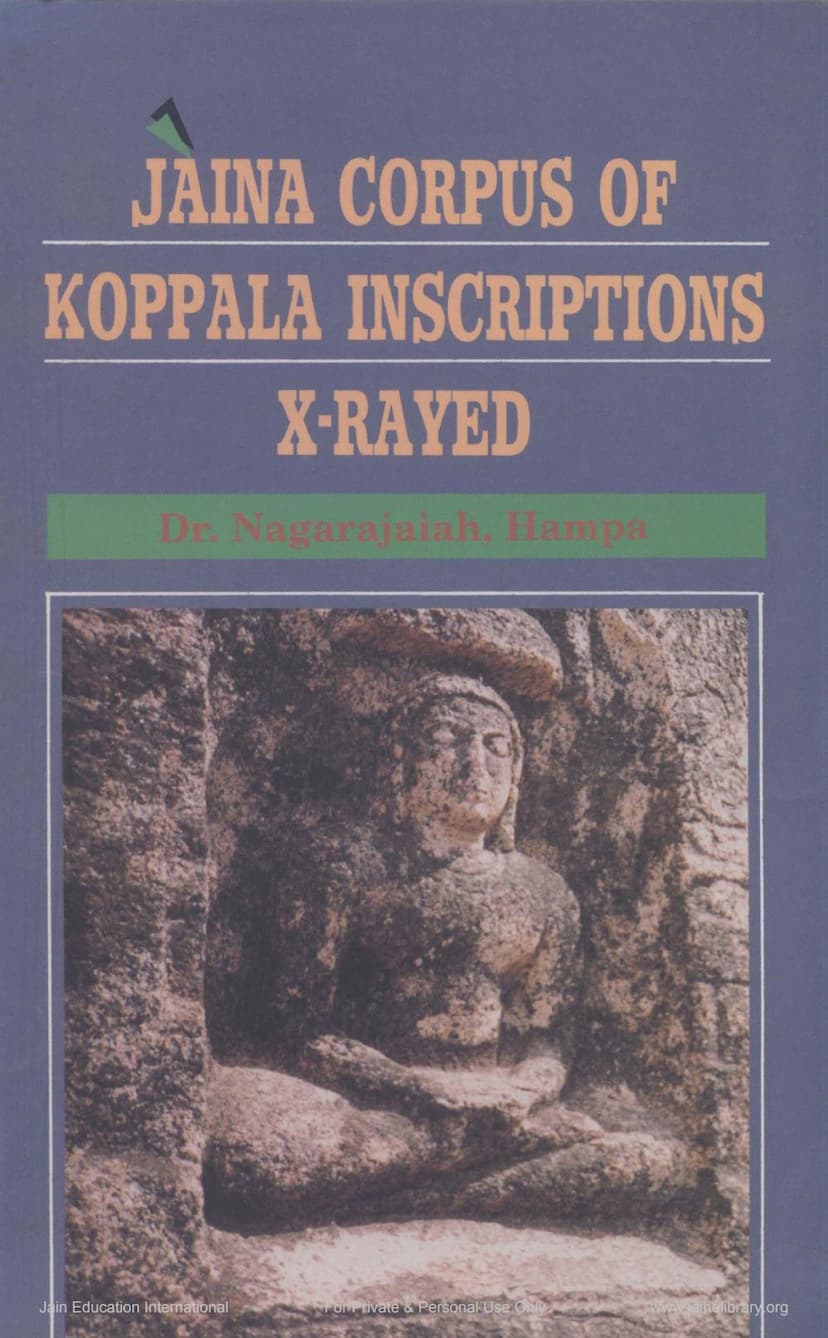Jaina Corpus Of Koppala Inscriptions X Rayed
Added to library: September 2, 2025

Summary
Here's a comprehensive summary of the Jain text "Jaina Corpus of Koppala Inscriptions X-rayed" by Dr. Nagarajaiah Hampa, based on the provided pages:
Book Overview:
"Jaina Corpus of Koppala Inscriptions X-rayed" is a monograph by Dr. Nagarajaiah Hampa, a distinguished scholar of Jainism and Karnataka history. Published by Ankita Pustaka, it delves into the cultural significance of inscriptions discovered in Koppala, a historically important Jain center in Karnataka. The book aims to shed light on the resurgence and supremacy of the Nirgrantha (Jain) cult in the region, particularly highlighting the role of ascetics and royal patronage.
Key Themes and Discoveries:
- Koppala as a Major Jain Center: The book establishes Koppala (also known by older names like Kopana, Kopanagiri, Kopana-tirtha) as a paramount Jain pilgrimage site, second only to Sravanabelagola, for nearly 1500 years. It was a hub for Jain art, architecture, sculpture, and literature, attracting monks, nuns, and lay followers.
- Discovery of Nisidhi Inscriptions: A significant discovery detailed in the book is a hoard of approximately 70 inscriptions found in 1992 when a portion of the Old Fort at Koppala collapsed due to heavy rains. Crucially, all these inscriptions are nisidhi (post-mortem memorial) epigraphs, providing invaluable new insights into Koppala's history as a Jain seat.
- Resurgence of the Nirgrantha Cult: The author emphasizes that these newly discovered inscriptions provide "indubitable proof of the resurgence and supremacy of the Nirgrantha cult" in Koppala. This resurgence was fueled by zealous friars and nuns who acted as missionaries.
- Role of Ascetics and Śyādvāda: The inscriptions highlight the peace-radiating personalities of ascetics and their spiritual lineage. They were masters of śyādvāda-siddhānta, the core of Jain philosophy, and their austerity and penance led them to salvation.
- Royal Patronage: A significant aspect discussed is the affiliation of kings, queens, princes, and princesses from dynasties like the Gangas, Rāṣṭrakūtas, and Kalyāṇa Cālukyas with Jainism. Royal patronage was crucial for the progress of any religion in ancient times, and Jainism in Karnataka profited immensely from it for over 1500 years, starting from Chandragupta Maurya.
- Inclusivity of Jainism: The book clarifies that while the nisidhi inscriptions predominantly focus on ascetics who renounced worldly life, Jainism's ultimate goal is attainable by all, including lay householders. The teachings of the Tirthankaras apply equally to the four-fold congregation: monks, nuns, male lay followers (upāsaka), and female lay followers (upāsikā).
- Chronological Span: The newly discovered inscriptions span from the 9th to the 13th centuries CE, indicating that Koppala served as a primary location for disseminating Jain teachings for a millennium.
- Theme of Sallekhanā: A central theme illuminated by these inscriptions is sallekhanā (or santhara), the voluntary ritual fasting unto death, considered one of Jainism's highest spiritual ideals. The inscriptions commemorate individuals, both ascetics and lay people, who embraced this rite.
- Socio-Cultural and Religious Significance: The inscriptions offer insights into the status of lay adherents, the integration of upāsakas into religious life, and the active role of organized lay followers in sustaining the Jain church. They also highlight the missionary zeal of Jain monks and nuns in propagating the faith.
- Literary and Linguistic Aspects: The inscriptions are predominantly in Kannada, with some Sanskrit verses. Their language and style reflect an archaic form, and some inscriptions showcase the genius of their composers, who possessed a sound knowledge of Jain tradition, poetry, and prosody.
- Decline and Destruction: The book touches upon the decline of Jainism in Koppala, particularly due to historical events like invasions and the destruction of temples and monasteries. Persian inscriptions from the 18th century suggest a final destruction of Jain monuments during that period.
- Specific Inscriptions and Personalities: The "Corpus of Koppala Inscriptions" chapter provides detailed summaries of numerous inscriptions (K.1 to K.68), often detailing the individuals who died by sallekhanā, their lineage, teachers, and the patrons who erected the memorial stones. Prominent personalities like Nayanandi Bhattāraka, Nemicandra Siddhāntadeva, Abhayanandi Panditadeva, Maladhārideva, Trikālayogi, and various Ganga royal family members are discussed.
- Contribution to Jainology: Dr. Nagarajaiah's extensive work is seen as a significant contribution to Jainological studies, providing crucial epigraphical evidence to understand the history and spread of Jainism in Karnataka.
Overall Impact:
"Jaina Corpus of Koppala Inscriptions X-rayed" is a scholarly work that meticulously analyzes newly discovered epigraphs from Koppala. It not only validates Koppala's historical importance as a Jain center but also offers fresh perspectives on the social, cultural, and religious life of the Jain community, particularly highlighting the enduring legacy of asceticism, royal patronage, and the philosophical underpinnings of Jainism as evidenced by the widespread practice of sallekhanā. The book serves as a valuable resource for scholars and anyone interested in the history of Jainism and the cultural heritage of Karnataka.